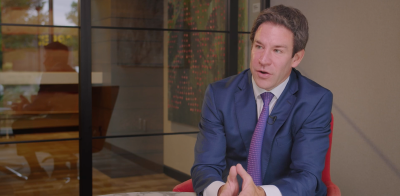Dare to Dream is now the base case
(And just for the record, I wrote this before last Friday’s blockbuster job report.)
The latest data series on the U.S. economy continue to roll in and they’re making investors say “Laissez les bons temps rouler”—let the good times roll! The data is truly painting a mind-bendingly rosy picture of the U.S. economy after a horrific pandemic, generational highs in inflation and the most aggressive Fed tightening1 campaign pretty much ever.
- Inflation continues its merciful retreat.
- The labor market has slowly evolved from white-hot to somewhere between just warm and hot, which bodes well for future near-term consumption while allowing potential further progress on the inflation front.
- Business fixed investment (BFI) continues to power onward—and with financial conditions easing considerably the past six quarters, sustained strategic onshoring of supply lines and substantial domestic production fiscal stimulus yet to be spent, and a rebound in corporate profitability, it is unlikely BFI retreats substantially in the near term.
- Residential investment has reentered what looks to be a sustained expansion phase after a nine-quarter contraction, and America’s epic single-family housing shortage should keep this gross domestic product (GDP) contributor positive as far as the eye can see.
- State and local government spending and investment continue to power ahead with no compelling reason to decline anytime soon (well, at least in states not named California).
- Labor hoarding has fortunately reduced the typical impetus for corporate America to start laying folks off as soon as profit margins erode. And with profit margins making a surprising rebound recently, the pressure to protect margins from pink slips should be less pronounced than a year ago.
Putting this all together, it now appears the Dare to Dream scenario of a Fed that hikes as much as possible—and keeps interest rates relatively high for as long as possible—without cratering the U.S. economy should now become the investment community’s base case outcome for at least the next 12 to 18 months.
And yet there are still risks
This wonderful development (for all of us who root for the U.S. economy—shame on you permabears) does not of course mean there aren’t still risks. A base case forecast does not equal a 100% probability of an outcome. The two data series that continue to concern me the most about the forward trajectory of the consumption-driven U.S. economy include a continued decline in withholding tax growth and the future of excess savings.
Withholding tax growth declines
The first quarter of 2024 has begun so far with another modest decline. If Q1 ends up in the red, it will mark four quarters in a row of contraction. However, the cause of this remains the same: Higher paying technology and financial service jobs at higher tax brackets continue to stagnate or be eliminated, even though the economy continues to churn out remarkable levels of job creation. Perhaps this most real-time indicator of the U.S. labor market will have provided another false recessionary signal like in 2018?
Excess savings will (eventually) run out
Despite earlier projections of excess savings running out by the summer of 2023, the latest estimates project they will last until the summer of 2024—and given the continued strength of the labor market, perhaps excess savings will last several quarters longer. However long this takes, they will certainly run out at some point in the near future and, with the personal savings rate dropping back down to near 60-year lows, the U.S. consumer’s shock absorption capacity has declined substantially.
So, as always, the U.S. economy continues to be driven by consumption and its future fate will be driven by the continued strength of the labor market.
Corporate America remains strong, but elevated valuations cause concern…
”Laissez les bons temps rouler” for the economy does not mean we are back in a “green-light-go,-figure-out how-much-risk-you-are-comfortable-taking,-and-then-double-it” market environment.
Now that corporate America has weathered a pandemic, a sustained bout of uncomfortably high inflation and the most rapid tightening of monetary policy pretty much ever without a substantial decline in profitability even WITH labor hoarding, it is unclear to say the least why the labor market is due for significant deterioration in the near term.
In terms of equity markets, the biggest obvious risk is elevated valuations at a time when money supply continues to stagnate, and the Fed continues to attempt to shrink their balance sheet while nominal GDP continues to soar. This in turn has led a massive decline in the excess liquidity the Fed provided during and after the acute stages of the pandemic (the Fed’s reverse repo facility has dropped from $2.3 trillion as recently as April of 2023, down to $503 billion now). However, the continued (some would say) excess utilization of the term bank funding program, implemented to keep weaker banks from failing, has short-circuited recent balance sheet contraction.
Thus, one cannot completely rule out a liquidity accident and potentially violent negative market price action in fixed income and equities during 2024.
And, as far as the fixed income market goes, despite rosy talk of recent “slightly lower than unhinged levels of deficits” or “hey, isn’t it great that the Treasury will issue slightly more T-bills than bonds,” the biggest risk continues to be massive, nearly limitless supply (without any political will to fix the underlying spending problem and without the largest price insensitive buyers willing to step in).
However, it appears the Fed is acutely aware of these risks, which is why they have begun to articulate either a tapering of quantitative easing (QE)2, or an outright early termination of the program, long before they reach the previously forecast target levels.
What Dare to Dream could mean for investors
The investment ramifications for Dare to Dream rapidly evolving to a base case outcome are fairly profound when it comes to fixed income, equities, liquid credit and cash.
Fixed income
“Chance,” as they say in Monte Carlo, to the perma-bearish fixed income managers and the “I-promise-you-I’ll-be-right-this-time-that-the-U.S.-economy-will-imminently-collapse-long-duration” crowd. One would think at this point that this crew would at least acknowledge the probability of a recession—and the Fed cutting aggressively and driving another meaningful drop in bond yields—has declined. The Fed is going to be patient with the size and speed of rate cuts (think of this as the mirror image of the 2015 to 2018 hiking cycle with a little more amplitude) and, since the yield curve is still already substantially inverted as fixed income managers pine for an economic calamity, the risk/reward profile of duration3 remains challenged.
Equities
Earnings growth may disappoint, but in a continued economic expansion with corporate profit margins ticking back up, it is highly unlikely earnings will decline in the near future. The issue for equities is less about fundamentals and more about valuations. As a reminder, various valuation measures—such as forward price-to-earnings (P/E) or price to free cash flow (P/FCF)—have only been more elevated in the dot-com bubble and in 2021. And believe me, I am sympathetic to the argument that, since free cash flow margins have climbed so much the last 25 years, the forward multiple of the S&P should be sustainably higher. However, at the current valuation levels, you just have much more muted upside and, if something goes modestly to horribly wrong, you have far more downside.
Liquid credit
Spreads are certainly tight, but base rates are still at the high end of the past 20-year range, and, without an imminent recession, it is highly unlikely default rates will skyrocket anytime soon. As a reminder, one of the central themes of last year’s SCALE conference in May was that classic corporate credit bust/default spikes (like the early 1990s or 2000–2002) are more than likely a thing of the past.
Cash, T-bills and money market positions
Most importantly, if you are holding off on rotating out of cash, Treasury bills (T-bills) and money market positions because you are fearful of an impending sustained economic downturn, you should probably rethink that thesis in due haste. This doesn’t mean you want to move from a conservative position to an overly aggressive one—we’re not going back to a green-light-go market environment anytime soon; it just means you want to start thoughtfully deploying that capital into investment strategies that may meaningfully outperform without taking substantial risk of loss or volatility risk.
Fight inertia and embrace (the right) alternatives
You don’t need to have a postdoc in statistics from UC Berkeley (see, I do love California) to understand that, given this economic and market backdrop, the northwest quadrant of the efficient frontier4 is the place to be— and the perfect home for at least a small portion of the $6.3 trillion increase in money market funds and commercial bank deposits (not to mentions $1.5 trillion more in CDs) since immediately prior to the pandemic.
If the 10-year Treasury yields were at 7% without an inverted yield curve, and the S&P 500 forward multiple was 14X like it was prior to the third round of quantitative easing (QE3), or if the Fed was printing money like in 2020 and 2021, there might be a rational argument against this view.
Within the realm of alternative investments, there are multiple attractive choices right now. But not all strategies are as attractive (the slogan is “The time for the RIGHT alts is still now” for a reason). Since I’m pretty jazzed up about Dare to Dream becoming this wonderful economic reality (the reality being sustained economic growth with higher rates for longer, more normalized levels of inflation and lower risk of recession), I will focus mainly on the strategies I believe to be best-positioned to monetize that sustained growth: private credit and middle market private equity.
Private credit may offer higher total return for longer
Private credit (and by this, I mean Private Senior Secured Commercial Real Estate Loans and Middle Market Corporate Loans with an emphasis on Asset Base Lending) has the potential to be a significant opportunity in the current Dare to Dream market scenario.
The nirvana environment for private lending has always been a Fed that hiked as much as possible and kept rates high for as long as possible without cratering the economy … and HERE WE ARE! Higher rates for longer equals more income for longer—and without the nasty hangover from higher realized default rates, which, in turn, means higher total return for longer. And since debt service costs have risen with higher borrowing costs and lenders have become more conservative (thank you, U.S. banking system for the asset duration mismanagement), leverage levels in loans originated since mid-2022 have come down substantially both in commercial real estate (CRE) and corporate loans.
Middle market private equity with an emphasis on secondaries could be a potential strategy for growth
I won’t go into tremendous detail on the exciting fundamentals of middle market PE with an emphasis on secondaries like I did in one of my previous strategy notes. I won’t even overwhelm you with an excess of the amazing metrics of this strategy over the past several years. However, let’s just focus on the following succinct list:
- Low teens annualized performance over a time period where the S&P 500 was up less than 5% annualized with 1/4 to 1/5 the volatility. I broke out the abacus and figured out those numbers are a lot better than cash and fixed income performance, too. They may also have been a little better than Emerging Markets, Europe, Japan and even the QQQs.
- Impressive historical positive performance in 2021, 2023 AND 2022 (the 60/40 trainwreck). How many strategies can say that?!
- Sustained mid-20% EBITDA growth of underlying companies through a challenging and confusing economic and market environment.
- Meaningfully cheaper valuations, lower leverage and a more transparent, sustained exit path than mega cap PE/LBOs.
- The best opportunity set for limited partner (LP) secondaries since the global financial crisis (GFC) and the best opportunity set for general partner (GP) led secondaries ever. Who doesn’t like to buy good assets at a 20% discount? Who doesn’t like to select the best assets from seasoned private equity drawdown vehicles after the original investors have lost their patience for another multiple year extension and just want liquidity?
And we can just keep it even simpler: What is one of the most optimal and attractive ways to monetize future U.S. economic growth without taking excessive volatility, risk of loss or valuation risk (keeping in mind that evergreen RIC investors or LP secondary investors buy at a discount while original drawdown fund investors sell at a discount)? Say it with me, “middle market PE!”
The other, suboptimal options
You could look outside of middle market PE, but you might not like what you find.
Venture capital
Sure, if you are a brave soul, you may be considering venture capital (VC), but those markets are a long way from healing as the recent boom (and now bust) cycle requires more time to fully play out. I thought residential and commercial real estate downturns were long, but this current extended VC downturn is making a play for the trophy … and this won’t just be a participation trophy!
The Magnificent Six
Yeah, the Magnificent Six stocks (excluding Tesla (TSLA) from the typically misnamed Magnificent Seven) are wonderful companies that will continue to dominate public market appreciation as far as the eye can see, but valuations are stretched and the bar for earnings and cash flow is extremely high. Any meaningful disappointment could lead to violent adverse price action—see the once improperly included TSLA.
Emerging markets
And yes, you could punt on emerging markets (EM) and international equities in the hope that China will “figure it out.” I know Japan is finally having a moment (great to see from at least a geopolitical standpoint and for those who have stayed invested there since the 1980s), and there will probably be one year out of 10 or 20 or 30 that European markets outperform the U.S.—but c’mon man! You invest in equities for growth, and it is now a global winner-take-all economy and market environment. And after China’s self-immolation, guess who has the all the winners? God bless the U.S.A.
Sure, one of these days, emerging markets as a whole will actually outperform the U.S. (to provide those interminably waiting for a flashback to the Lost Decade a reason to smile for at least a few months, quarters or maybe even a year or two). And to be fair, out of the original submerging or completely submerged BRICS countries, India is the lone bright spot.
Vintages
And hey, you could allocate to the 75th vintage—or is it the 85th? There are just so many—and I ran out of fingers and toes long ago—of the major, blue chip mega cap leveraged buyout (LBO) buyout firms. But let’s face it—unless they start raising a lot more money soon, the game of selling one company from PE firm #1 to PE firm #2 is over.
Higher debt service costs on highly leveraged balance sheets are really crimping organic growth and it is unlikely that a robust initial public offering (IPO) market will be roaring back anytime soon to provide monetization opportunities. There are a lot of reasons these vintages keep extending and driving record levels of secondary sales volume and none of them will drive higher current and future internal rate of returns (IRRs) for existing investors.
However, the far more rational approach is for investors to focus on one of the few areas of the global economy and markets where attractive growth is highly probable—and where the risk of loss and extreme volatility is fairly low: U.S. middle market private equity. And if you can access it through a democratized evergreen fund structure, better yet!
Conclusion: Don’t leave cash on the sidelines
Lastly, it’s so-far-so-good for investors that started the year rotating out of cash into the right alternatives. Pretty much every strategy (CRE lending, corporate private credit, middle market PE, multi-strategy and dynamic credit) has outperformed cash so far this year.
Obviously, if markets had crashed, dynamic credit and maybe middle market PE and multi-strategy would have underperformed cash, T-bills and money markets; but since that didn’t happen—so far so good.
Investing in alternatives is different than investing in traditional investments such as stocks and bonds. Alternatives tend to be illiquid and highly specialized. In the context of alternative investments, higher returns may be accompanied by increased risk and, like any investment, the possibility of an investment loss. Investments made in alternatives may be less liquid and harder to value than investments made in large, publicly traded corporations. When building a portfolio that includes alternative investments, financial professionals and their investors should first consider an individual’s financial objectives. Investment constraints such as risk tolerance, liquidity needs and investment time horizon should be determined.




